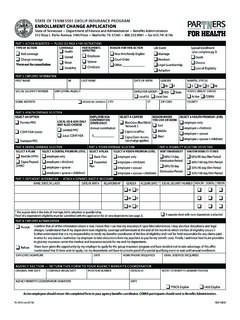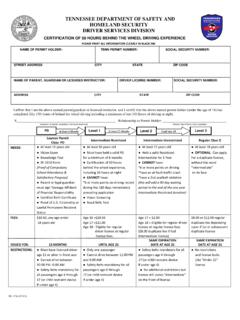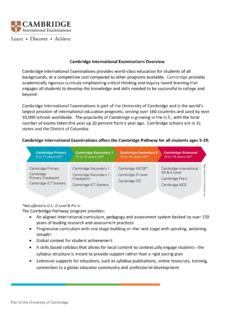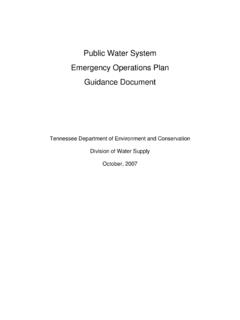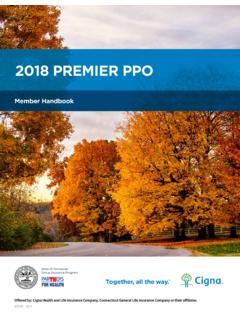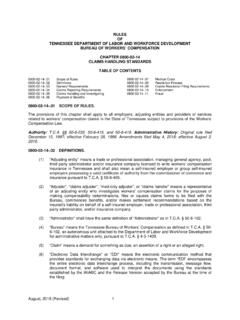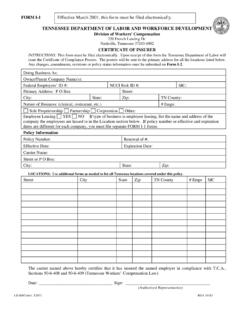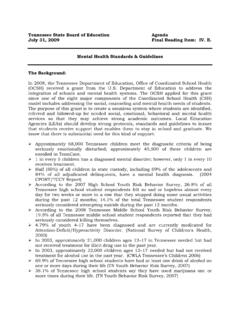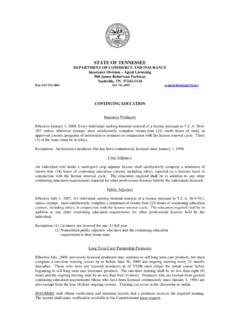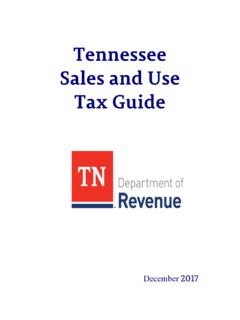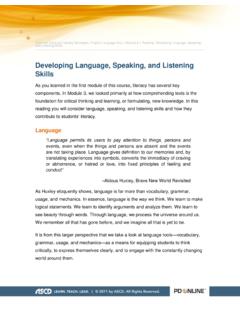Transcription of Tennessee Early Learning Developmental Standards
1 Tennessee Early Learning Developmental Standards 2 Guiding Principles for the Tennessee Early Learning Developmental Standards All children are capable of Learning , achieving, and making Developmental progress. The Early Learning Developmental Standards (ELDS) are intended for all children regardless of economic, linguistic, and cultural differences and/or physical, Learning , or emotional challenges. Children develop at different rates and each child is unique in his or her own development, growth, and acquisition of skills. Individualized, appropriate, and reasonable supports and accommodations must be provided to close the achievement gap and promote school readiness for all children. Early experiences have both cumulative and delayed effects on each individual child s development; optimal periods exist for certain types of development and Learning . Four-year-old children are active, eager learners.
2 A primary approach to Learning is through purposeful, inquiry-based play. Optimal Learning environments invite children s participation through hands-on, experiential exploration using all five senses. Four-year-olds are concrete learners who learn best through interactions with people and educational materials in multiple, varied contexts. Development advances when children have opportunities to practice newly acquired skills and when they experience a challenge just beyond the level of their present mastery, known as the zone of proximal development. Multi-dimensional development is essential for optimal brain growth. Children s Learning is integrated and occurs simultaneously across all Developmental domains, which are interrelated and interactive with one another. Children s brain growth and cognitive development is accelerated when Early education is focused and balanced among all eight areas of development included in the revised TN ELDS.
3 Children learn in the context of interactions and relationships with family members, caregivers, teachers, other children, and adults in their immediate environment and greater community. The family is the most significant contributor to a child s lifelong Learning and development. Engaging families in the Early education of their children is essential to continuing a child s success in the elementary classroom and later Learning . 3 Common Terms and Intended Meanings The following lists of terms are found in the Standards for four-year-olds. Understanding the meanings of these words will better support understanding of the Standards . List of Terms & Intended Meanings Four-Year-Old Standards Only Associate: to connect with something else in one s mind Aware or awareness of: knowing or cognizant of Begin to: The first step in the process; the child may not demonstrate complete mastery of the skill but demonstrates an awareness of the concept and evidence of Learning Categorize: to arrange by categories; to describe or understand by assigning to a category Classify: to group or order in classes Compare: to note or describe the similarities or difference of; to bring together for the purpose of discovering similarities and differences Contrast: to compare in order to make differences clear; to show or reveal differences when compared Count: to list or name one by one in order Create: to bring into being; to cause, produce Define: to explain or state the meaning of.
4 To describe the nature of Demonstrate: to show evidence; to reveal; to show Describe: to tell or write about; create a picture of in words Develop: to bring out the potential of; advance to a more complete or more effective condition; to gain strength Display: to cause to be seen; show; to make known; disclose Expand: to make larger or wider; to become larger or wider Explore: to begin to understand by carefully examining Express: to show or make known; to tell the thoughts or feelings Familiar: those letters, words and ideas with which students come in contact on a regular basis ( , own name, billboards, signs, books read regularly, items in the environment) Identify: to figure out or show who someone is or what something is; to connect or associate Initiate: to cause to begin; start; originate Observe: to notice or see; to watch closely; make a careful observation Participate: to take part; share (usually followed by in ) Progress: forward movement toward an end; forward movement in time or space React: to act, or feel a certain way, in response to something Recall: to bring a past event into the mind; remember Recognize: to identify from an earlier experience; to understand Relate: to tell the story of; to see or find connections between; link Reproduce: to make a copy of; to make or produce again Respond: to answer or give a reply, in words or through other means 4 Retell: to tell again, , a story or account Select: to choose; pick Sustain: to keep (something) going or existing Understand: to get the meaning , nature, or importance of Use: to bring into service TN ELDS and Instruction The TN ELDS and Kindergarten Standards tell what students need to know and learn.
5 The instructional strategies based in Developmental science tell how students will learn and grow toward the Standards . The instructional structures ( , centers, whole group, etc.) tell where the Learning will occur. Unpacking the Standards Steps toward Effective Implementation In order to plan for effective daily instruction that aligns with the expectations of the Standards , it is important to begin with a clear understanding of what Standards are asking students to learn and be able to do. To do so, teachers should unpack the Standards in the following way: 1. Write the Learning standard; 2. Identify what children need to know knowledge/concepts; , describe measurable attributes of a single object, such as length, width, height. 3. Identify what the children need to do; , describe attributes of a shape. 4. Connect each verb with Bloom s taxonomy; a. Low: Remember and Understand b.
6 Middle: Apply and Analyze c. High: Evaluate and Create 5. Consider; a. The sequencing of Learning goals what comes before or right after this skill? b. Are there any vocabulary words which need to be identified or clarified? c. What prior knowledge and skills are needed to master this Learning goal? Note on Coding The Standards are coded with the grade level, title of the strand, the category within the 5 strand, and the number within the strand. In a few cases, a letter might also be used to delineate subsections. Example: Pre-K (PK) is the grade level. Foundational Literacy (FL) is the strand. Print Concepts (PC) is the category. 1 is the number of the standard within the strand. Linking Standards The Standards in this document are meant to be taught through an integrated approach. By helping students make connections to text and/or real life experiences, Learning is meaningful and more easily transferred.
7 Linking Standards signal that planning for instruction needs to begin with a high quality text and that planning decisions with the Standards center on the selection(s). Speaking and Listening Standards are aligned with other English language arts Standards to provide teachers with guidance regarding where these Standards might be embedded within instruction. Oral language development is essential to later reading skills. Speaking and Listening Standards should be taught with the same intentionality as all other Standards . Approaches to Learning ( ) Creativity: Actively engage in Learning with curiosity, flexibility, and openness to new ideas. Independently interact with a variety of materials through multiple play activities. Self-select play activities to support own curiosity and to engage in pretend and imaginative play ( , testing theories, acting out imagination).
8 Choose materials/props and use novel ways to represent ideas, characters, and objects in symbolic play. Demonstrate a willingness to engage in new experiences and activities. Self-Regulation: Engage in Learning to effectively plan and problem solve. Maintain focus appropriate to completing a task and/or Learning activity. Persist in solving a problem or question, with adult prompting. Reflect and plan a logical series of steps to accomplish a task, such as writing a message, completing a puzzle, drawing a picture, or building a block structure. Critical Thinking: Actively inquire and reflect about new ideas and activities. Seek additional clarity to further own knowledge ( , asks what, how, why, when, where, and/or what if). Demonstrate an awareness of connection between prior and new knowledge. 6 Identify a problem and attempt multiple ways to solve it, with or without assistance. Communication: Actively engage in conversations with adults and peers.
9 Ask and respond to questions with peers and adults in individual and group activities. Seek assistance and/or information when needed to complete a task. Collaboration: Actively engage in Learning with other people. Engage in play-based, student-directed activities with a peer or peers ( , dramatic play, block building, symbolic play in recess) for at least 15 consecutive minutes, at multiple times throughout the year. Demonstrate a willingness to collaborate with others to solve a problem. Social and Personal Competencies ( ) Self-Awareness: Demonstrate an awareness of emotions, personal qualities and interests, personal abilities, and sense of personal responsibility. Express feelings, needs, opinions, and desires in a way which is appropriate to the situation. Appropriately name types of emotions ( , happy, sad, frustrated) and associate them with different facial expressions, words, and behaviors.
10 Describe self using several different identifying characteristics and/or unique qualities ( , abilities, interests, gender, culture). Develop a basic awareness of self as an individual, self within the context of family, and self within the context of community. Display sense of accomplishment, contentment, and acknowledgement when completing a task or solving a problem. Seek and accept guidance from primary caregivers, teachers, and other familiar adults. Demonstrate an understanding of rules through actions and conversations. Use materials purposefully, safely, and respectfully as set by group rules. Self-Management: Understand and use strategies for managing emotions and behaviors constructively. Express feelings, needs, opinions, and desires and begin to identify causal relationships. Demonstrate ability to modify behavior in different situations using multiple problem solving strategies ( , trade, take turns, share, wait) with or without adult guidance and support.
